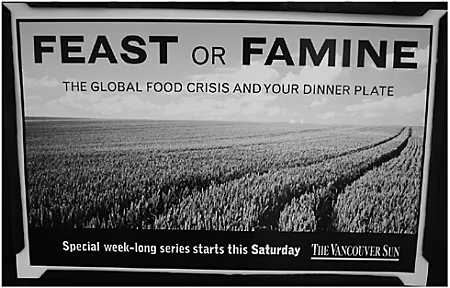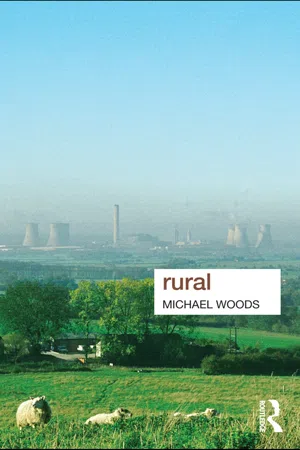The city and the country
The distinction between ‘urban’ and ‘rural’, between the city and the country, is one of the oldest and most pervasive of geographical binaries. The terms may have originated as a way of differentiating between the enclosed and defensible spaces of early towns (Box 1.1), and the open and uncontrollable spaces that lay outside, but they soon acquired greater symbolic significance as they became embedded in language and culture. As Raymond Williams observed, ‘“country” and “city” are very powerful words, and this is not surprising when we remember how much they seem to stand for in the experience of human communities’ (1973: 1). For Williams, the two terms were inextricably connected and the connection represented the progression of human society. As such, he noted, both the ‘country’ and the ‘city’, the ‘rural’ and the ‘urban’, had collected powerful feelings and associations:
The development of ‘rurality’, or ‘the country’, as an idea in popular culture is discussed further in Chapter 2. For the moment, it is sufficient to note that the binary of ‘urban’ and ‘rural’ has also been incorporated into the organization of geography as an academic discipline, and that the popular cultural associations of the city and the country have been influential in setting the parameters of ‘urban geography’ and ‘rural geography’ and in defining their objects of inquiry.
In the early development of geography as an academic discipline, during the first two-thirds of the twentieth century, the study of both the city and the country were linked within the broader approach of ‘regional geography’. This approach sought to describe the geographical characteristics of specified regions and in doing so tended to reproduce popular assumptions about the relationship between the city and the country. Thus, the geographies of rural areas tended to be described and explained in terms of their functional relationship to urban centres as sources of food and natural resources. Attempts were made to convert these popular perceptions into scientific theories by producing general models of the relationships between urban and rural areas, which could in theory be applied to any region. Such models included von Thünen’s concentric model of land use, which mapped out types of farming in relation to the proximity of rural areas to cities (originally designed by a German economist Johann Heinrich von Thünen in 1826, but not translated into English until 1966); and ‘central place theory’ developed by Walter Christaller in 1933 (and modified by August Lösch in 1954) to explain the hierarchy of rural and urban settlements.
In practice, these models failed to capture the diversity and dynamism of rural areas, and frequently did not fit when applied empirically. Nonetheless, they prefigured the development of a new systems-based approach in geography in the 1960s that critiqued regional geography for being overly descriptive and lacking scientific rigour. Applying positivist principles of scientific inquiry and interrogating quantitative data to identify patterns and laws of spatial organization, the new ‘spatial science’ began to focus in on the city as its major object of research (Hubbard, 2006). The emergent ‘urban geography’ concerned itself with mapping and modelling ‘urban systems’, which could extend to and encompass rural areas, but which in effect marginalized the rural as an adjunct to the urban. Significantly, there was no equivalent investigation of ‘rural systems’, but rather the development of a ‘systematic agricultural geography’ that reinforced the association of the rural and farming (Woods, 2009a).
It was not until the early 1970s that an integrated approach to studying ‘rural geography’ was articulated, notably in textbooks by Clout (1972) in Britain, and Hart (1974) in the United States. These books recognized that the rural was more than agriculture, but they nonetheless presented the rural as a coherent and distinctive system, centred on productive land uses. This tension remained apparent in the new ‘rural geography’ that these interventions inspired. On the one hand, rural geography uncritically accepted the existence of ‘rural space’ as a container for the phenomena that they studied, yet, on the other hand, their attempts to distil the essence of the rural, and to authoritatively map the boundaries of rural and urban space, were compromised by methodological problems in fixing the scale of analysis, by the arbitrary spatial units of available data, and by the arbitrary nature of the indicators selected (Cloke, 2006).
Conceptual developments in rural geography
The trajectory followed by rural geography since the 1970s has been strongly influenced by wider conceptual developments in human geography (and in the social sciences more widely), in the shifting focus of its objects of study, in the explanations that it has presented for the processes and phenomena observed, and in its definition of the rural. Early research in rural geography, as described above, followed the principles of positivism, which held that objective facts could be uncovered through empirical inquiry. As such, rural geographers sought to objectively define the rural by searching for the functional characteristics that could be statistically proven to be different from urban characteristics. However, as Cloke (2006) demonstrates, the functional approach was flawed in its assumptions and undermined by its methodological weaknesses. Functional concepts of rurality could describe the characteristics of specific rural spaces and rural societies, but they could not prove that such characteristics were intrinsically rural, or explain how these characteristics shaped the realities of rural life.
The inadequacies of the functional approach were further exposed by the development of a new wave of studies in the 1970s and 1980s that adopted a political-economy approach, influenced by neo-Marxist theories of the operation of capitalism (see Buttel and Newby, 1980; Cloke, 1989a; Woods, 2005a, 2009a). Some of these studies contributed, alongside work in rural sociology, to a political-economy analysis of agriculture that emphasized the structuring of farming as a capitalist industry, subject to the same imperatives for capital accumulation as other industries. There was no place in this perspective for nostalgic a...

